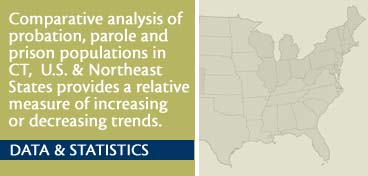| Research, Analysis & Evaluation |
STATISTICS |
|
[$XQ=384746$] | |||||
 |
| |||||
| PROBATION, PAROLE & SENTENCED PRISON POPULATION REPORT | ||
|
The report below is available in Adobe PDF format, to view it get the Adobe Reader. |
| OVERVIEW | ||
|
This document provides a comparative analysis of rates and numbers of probation, parole and sentenced prison populations for Connecticut, the United States and a cohort of other Northeast states – Rhode Island, Massachusetts, New York, New Jersey, and Pennsylvania. The purpose of this document is to provide a relative measurement of increasing or decreasing rates and numbers of those statistics, by comparison, to those same geographic areas.
This data is collected by Bureau of Justice Statistics (BJS) in their Annual Probation and Parole Survey and their National Prisoner Statistics (NPS) program. BJS depends entirely upon the voluntary participation of: State Departments of Corrections and the Federal Bureau of Prisons for NPS data; and State central reporters and separate State, county, and court agencies for probation and parole data.
For more information, see Data Collection Methodology
|
| DATA COLLECTION METHODOLOGY | ||
|
The data developed for this report is derived from two standard annual data series prepared by the U.S. Department of Justice, Bureau of Justice Statistics (BJS):
(1) Prisoners in 2006, 2004 and 2005 (2) Probation and Parole in the United States 2006, 2005 and 2004 Where necessary, data were imputed (estimated) by BJS for non-reporting agencies using a variety of methods, depending on data availability. Population estimates for both publications were provided by the U.S. Census Bureau.
Methodology: Prisoners in 2006
This publication reports the number of persons in State and Federal prisons at year end, compares the increase in the prison population with previous years, and gives the prison growth rates over a 5 year time period. Prisoner data is collected via the National Prisoner Statistics (NPS) program that collects statistics on prisoners at midyear and year end. The Census Bureau serves as the data collection agent for BJS. BJS depends entirely upon the voluntary participation of State Departments of Corrections and the Federal Bureau of Prisons for NPS data. Jody Barry of the Department of Correction’s MIS and Research Unit is responsible for providing the prisoner data for these annual surveys. The NPS data collection instruments can be found at http://www.ojp.usdoj.gov/bjs/correct.htm#Programs The NPS custody counts include all inmates held within a responding jurisdiction’s facilities, including inmates housed for other jurisdictions. The custody counts exclude inmates held in local jails and in other jurisdictions. With a few exceptions for several responding jurisdictions, the NPS custody counts exclude inmates held in privately operated facilities. The NPS counts also include all inmates in State-operated facilities in Alaska, Connecticut, Delaware, Hawaii, Rhode Island, and Vermont which have combined jail-prison systems.
Methodology: Probation and Parole in the United States, 2006
This publication presents the number of persons on probation and parole at year end by State, and compares the national totals to counts with previous years. Beginning in 1980 the Annual Probation Survey and Annual Parole Survey collected data on the total number of persons supervised in the community on January 1 and December 31 of each year and on counts of the number persons entering and exiting supervision during the year. These surveys cover the Federal System, all 50 States, and the District of Columbia. BJS depends entirely upon the voluntary participation of the State central reporters and the separate State, county, and court agencies for the annual probation and parole data. Jody Barry of the Department of Correction’s MIS and Research Unit is responsible for providing the data for the annual parole surveys. An example of a Parole Survey data collection instrument can be found at
http://www.ojp.usdoj.gov/bjs/pub/pdf/cj7_05.pdf Brian Hill and Susan Glass of the Connecticut Judicial Branch, Court Support Services Division (CSSD) are responsible for providing the data for the annual probation surveys collected by BJS for Connecticut. An example of a Probation Survey data collection instrument can be found at: http://www.ojp.usdoj.gov/bjs/pub/pdf/cj8_05.pdf Because many States update their population counts, the January 1, 2006, numbers may differ from those previously published for December 31, 2005.
| ||
| CONNECTICUT DATA CAUTIONS | ||
|
For sentenced offenders, the Bureau of Justice Statistics (BJS) uses a baseline which begins at the point of sentences of one year or more. In Connecticut, offenders must be serving sentences greater than two years to be considered for Parole, which may be different from many states. Furthermore, the Connecticut Department of Correction has the discretionary release authority for those offenders sentenced less than two years. Connecticut's comparative numbers would be significantly increased if those offenders released between the one and two year mark were included in the BJS analysis. Those offenders generally, have higher rates of community release approvals. Under the BJS data collection methodology for sentenced offenders, they are not included in Connecticut's data because they are not eligible for Parole. However, these offenders are eligible for a variety of transitional supervision programs under the auspices of the Connecticut Department of Correction. We are mindful of not wanting to create additional confusion by mixing our methodology for calculating these numbers with the BJS methodology for sentenced offenders. In order to achieve a relative sense of Connecticut's ranking vis-à-vis the other 50 states, we have presented Connecticut's numbers based upon the BJS definition of sentenced offenders. |


